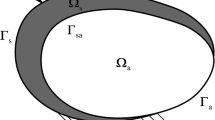Abstract
This paper analyzes the random response of structural-acoustic coupled systems. Most existing works on coupled structural-acoustic analysis are limited to systems under deterministic excitations due to high computational cost required by a random response analysis. To reduce the computational burden involved in the coupled random analysis, an iterative procedure based on the Pseudo excitation method has been developed. It is found that this algorithm has an overwhelming advantage in computing efficiency over traditional methods, as demonstrated by some numerical examples given in this paper.
Similar content being viewed by others
References
Gladwell, G. M. L., Zimmermann, G.: On energy and complementary energy formulations of acoustic and structural vibration problems. Journal of Sound and Vibration 3(3), 233–241 (1966)
Nefske, D. J., Wolf Jr J. A., Howell, L.J.: Structural-acoustic finite element analysis of the automobile passenger compartment: a review of current practice. Journal of Sound and Vibration 80(2), 247–266 (1982)
Everstine, G. C.: Finite element formulations of structural acoustic problems. Computers & Structure 65(3), 307–321 (1997)
Goswami, P., Rizzo, F. J., Shippy, D. J.: Acoustic scattering by elastic solids using the boundary element method. Review of Progress in Quantitative NDE 7B, 95–102 (1988)
Li, S.: Anefficient technique for multi-frequency acoustic analysis by boundary element method. Journal of Sound and Vibration 283, 971–980 (2005)
Renji, K., Nair, P. S., Narayanan, S.: Acoustic response behaviour of panels mounted with equipment and its prediction using statistical energy analysis. Journal of Sound and Vibration 289, 851–870 (2006)
Dong, J., Choi, K. K., Wang, A., et al.: Parametric design sensitivity analysis of high frequency structural-acoustic problems using energy finite element method. International Journal of Numerical Methods in Engineering 62, 83–121 (2005)
Keiji, S., Toyoki, S.: Research on aerodynamic noise around automobiles. Society of Automotive Engineers of Japan Review 16(2), 157–164 (1995)
Davies, H. G.: Low frequency random excitation of waterloaded rectangular plates. Journal of Sound and Vibration 15(1), 107–126 (1971)
Mathur, G. P., Chin, C. L.: Sound transmission through stiff-ened aircraft structures. In: Proceeding of NOISECON96. Inst. of Noise Control Engineering, Saddle River, NJ, 199–204 (1996)
Mixson, J. S., Wilby, J. F.: Chapter 16. Interior noise. In: Hubbard HH. Aeroacoustics of Flight Vehicles, Noise Control, 2. Acoustical Society of America (1995)
Lin, Y. K., Zhang, R., Yong, Y.: Multiply supported pipeline under seismic wave excitations. Journal of Engineering Mechanics 116, 1094–1108 (1990)
Lupoi, A., Franchin, P., Pinto, P. E., et al. Seismic design of bridges accounting for spatial variability of ground motion. Earthquake Engineering and Structural Dynamics 34, 327–348 (2005)
Kiureghian, A. D., Neuenhofer, A.: Response spectrum method for multi-support seismic excitations. Earthquake Engineering and Structural Dynamics 21, 713–740 (1992)
Ernesto, H. Z., Vanmarcke, E. H.: Seismic random vibration analysis of multi-support structural systems. ASCE Journal of Engineering Mechanics 120(5), 1107–1128 (1994)
Kiureghian, A. D., Neuenhofer, A.: A discussion on Seismic random vibration analysis of multi-support structural systems. ASCE Journal of Engineering Mechanics 121(9), 1037 (1995)
Ernesto, H. Z., Vanmarcke, E. H.: Closure to “Seismic random-vibration analysis of multisupport-structural systems” by Ernesto Heredia-Zavoni and Erik H. Vanmarcke. ASCE Journal of Engineering Mechanics 121(9), 1037–1038 (1995)
Lin, J. H.: A fast CQC algorithm of PSD matrices for random seismic responses. Computers & Structure 44, 683–687 (1992)
Lin, J. H., Zhao, Y., Zhang, Y. H.: Accurate and highly efficient algorithms for structural stationary/non-stationary random responses. Computer Methods in Applied Mechanics and Engineering 191, 103–111 (2001)
Zhang, Y. H., Lin, J. H., Williams, F. W., et al.: Wave passage effect of seismic ground motions on the response of multiply supported structures. Structural Engineering and Mechanics 20(6), 655–672 (2005)
Zhang, Y. H., Li, Q. S., Lin, J. H., et al.: Random vibration analysis of long-span structures subjected to spatially varying ground motions. Soil Dynamics and Earthquake Engineering 29(4), 620–629 (2009)
Craggs, A.: The free vibration of systems with proportional or light dam**. Journal of Sound and Vibration 170(1), 130–139 (1994)
Craggs, A.: A finite element method for the free vibration of air in ducts and rooms with absorbing walls. Journal of Sound and Vibration 173(4), 568–576 (1994)
Ma, Z. D., Hagiwara, I.: Sensitivity analysis methods for coupled acoustic-structural systems. Part I: modal sensitivities. AIAA Journal 29(11), 1787–1795 (1991)
Clough, R. W., Penzien, J.: Dynamics of Structures. 2nd edn, McGraw-Hill, New York (1994)
Gu, Y. X., Zhang, H.W.: New generation software of structural analysis and design optimization-JIFEX. Structural Engineering and Mechanics 7(6), 589–599 (1999)
Borisyuk, A. O., Grinchenko, V. T.: Vibration and noise generation by elastic elements excited by a turbulent flow. Journal of Sound and Vibration 204(2), 213–237 (1997)
Author information
Authors and Affiliations
Corresponding author
Additional information
The project was supported by the National Natural Science Foundation of China (11072049, 10772038), the Key Project of Chinese National Programs for Fundamental Research and Development (2010CB832703), the National Key Technology Support Program (2009BAG12A04) and the Program for New Century Excellent Talents in University.
Rights and permissions
About this article
Cite this article
Zhao, GZ., Chen, G. & Kang, Z. An iterative algorithm for analysis of coupled structural-acoustic systems subject to random excitations. Acta Mech Sin 28, 458–467 (2012). https://doi.org/10.1007/s10409-012-0032-8
Received:
Revised:
Accepted:
Published:
Issue Date:
DOI: https://doi.org/10.1007/s10409-012-0032-8




